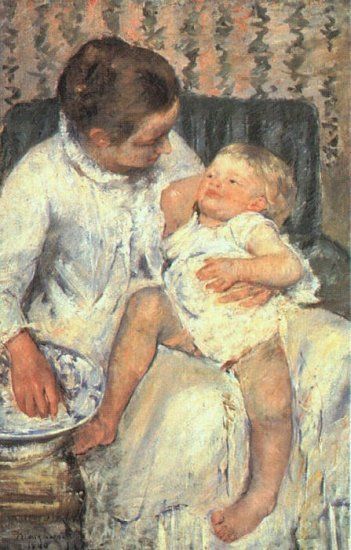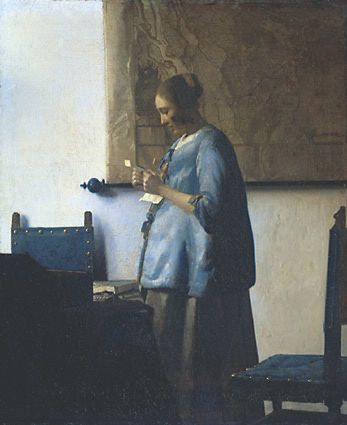
Mary Cassatt was one of the few female Impressionist painters. Although she was an American she moved to Paris after studying at the Pennsylvania Academy of the Fine Arts, and lived there for the duration of her life. While there, she met Degas who invited her to submit her work in the fourth Impressionist exhibition in 1879.1 Mary Cassatt’s body of work consists primarily of paintings of women in domestic and social settings. She had always exhibited an interest in painting scenes of mothers and their children. But it wasn’t until 1880 when her brother, Alexander, arrived in Paris with his young family that she was provided the opportunity to study and paint children from life.3 One of Cassat’s earliest work on the theme of mother and child, is entitled Mother About to Wash her Sleepy Child (1880). In this particular painting Mary Cassatt is not only able to capture an exact moment in time in doing this it becomes an image that has great significance to her body of work.
Impressionists were a closely-knit group of artists that “stressed the need for recording momentary sensations on the canvas and the importance of spontaneity.”4 They thought it important to record how the eye really sees, by sometimes depicting figures cut off or caught in spontaneous movement. Their brush marks were used as a way to not only capture light but also to capture the constant motion of all life.4
The brush strokes of Mary Cassatt’s painting do a great job of portraying motion. The outlines of the figures are blurred and there are no contour lines, suggesting motion from both subjects. Since there are no set outlines the forms of the bodies are portrayed by the use of color and brush strokes. It seems as though it was painted in a frenzy; there are long sweeping strokes like she used in the lower portion of the mothers dress, juxtaposed with short brush strokes that she used to create the look of the wash basin and the baby. The suggestion of movement in the way the work was painted was not only a common Impressionist technique, but in the case of this particular work, it was also a way to represent the subjects of the painting. A baby perched on a mother’s lap is not going to be a stationary object, it’s going to squirm and move about and because of this it’s mother will have to move around as well in order to keep control of her child.
For the Impressionists it was just as important to capture the lighting of a moment as it was to capture the movement. The painting utilized pastels, creating a very bright image. The mothers dress seems to glow white in the light, while the child’s face is illuminated, almost as bright as his light blonde hair. Pastels seemed the right choice for this kind of image because they are colors that pick up the light and make the image brighter and this is an image of intimacy and sweetness. The combination of the loose brushwork and the pastel colors are very representative of the Impressionist movement.
Mary Cassatt has done and excellent job in this painting of capturing an exact moment in time. The momentarines of the image is best represented by the position of the child’s left foot. It’s turned inwards in a very awkward manner. It is not positioned in a way to suggest a child was posing for the picture. This suggests that, as mentioned before, the child was squirming and, in the moment Cassatt was trying to capture, his foot was turned in an odd angle. Also, as mentioned before, Impressionist painters thought it important to represent a moment just as a person would view it from their own eyes. They would sometimes cut off some parts of their subjects by leaving it off of the canvas. Cassatt has cropped the woman’s elbow with the edge of the canvas’s frame and cut off her legs and a part of her knee. The painting is more similar to how the eye would see it. Rarely do people view the entire image, rather they focus in on a particular sights. Cassatt has put a lot of thought into how she frames her subjects. “Proximity and compression are also characteristic of the works of Cassatt.”4 There is a reason that she has painted her subjects up close. In Pollock’s article she describes another one of Cassatt’s images, Young Woman in Black: Portrait of Mrs. Gardener Cassatt (1883) but her description also holds true to this painting as well; “the viewer is forced into a confrontation or conversation with the painted figure while dominance and familiarity are denied by the device of the averted head of concentration on an activity by the depicted personage.”2 In other words, it forces the viewer to become even more intimate with an already intimate image.
The theme of the image is supported by form and content. It is a picture about mothering and nurturing and its supported by many circular forms. The mother’s head is circular topped with a rounded bun, the child is one large plump circle, the mother’s extended hand leads the eye to the circular bowl where her fingers curl in it to form yet another circular shape. It is representative of the female form, swelling breasts and round stomach when baring a child, and most importantly reminiscent of the womb. All of these suggested forms support the theme of the painting- mother and child.
The only thing that makes this painting different from the typical Impressionist paintings is that it takes place indoors as opposed to the prevalent outdoor scenes. Positioned next to Cassatt’s painting in the same room, was a painting by Gari Melchers entitled Writing (1905-9). It is a depiction of a woman sitting down at her desk to write a letter. It too is an image of a female in a domestic space involved in an intimate activity. The museum was probably trying to show a dialogue between the two images about the theme of women in domestic spaces instead of the general theme of Impressionist paintings. Melcher’s painting called to mind Vermeer’s paintings of women with letters. (For example, Woman in Blue Reading a Letter c. 1662-1665.) These images can both be compared with Cassatt’s as well. Both Melcher and Vermeer paint a female figure in a domestic setting and although they are alone, the idea of a male figure is also present through the letter the women hold. Cassatt’s mother is participating in a very intimate feminine activity but the idea of a male figure in her life is still present by her child, which could not be conceived without a male.

Though Cassatt’s painting is similar to Vermeer’s paintings in theme, it is very different in content. Where Vermeer’s work is dark and although it seems that the viewer is a voyeur witnessing an intimate moment of femininity, the colors, movement and framing of the images are quite different. Cassatt’s painting is Impressionist so the image is comprised of pastels and bright lighting. The subjects look as if they are moving around, and in Vermeer’s it looks as though the women could have been posing for the painter.
Mary Cassatt’s use of vibrant color, bright light, loose brush strokes and theme all came together to produce a great example of Impressionist art. As an example of Cassatt’s earlier work, this painting is a great representation of Impressionism and is a great starting point for her many paintings of the mother and child theme.
1. Stokstad, Marilyn. Art History. New Jersey: Prentice-Hall, Inc., 2002
2. Pollock, Griselda. Vision and Difference: Femininity, Feminism and the Histories of Art. London: Routledge, 1988.
3. “Mary Cassatt; The First Lady of Impressionism” WetCanvas.com 25 Mar. 2003
www.wetcanvas.com/museum/artists/c/mary_cassatt/mother.html
4. “Impressionism (1870s – 1890s)” Humanities Web 25 Mar. 2003 www.humanitiesweb.org/cgi-bin/human.cgi?s=g&p=i&a=d&ID=12
5. Mary Cassatt. Mother About to Wash her Sleepy Child. 1880. Oil on Canvas, 62x8x14
6. Johannes Vermeer. Woman in Blue Reading a Letter. 1662-1665. Oil on Canvas, 18 1/4x15 3/8 in.

